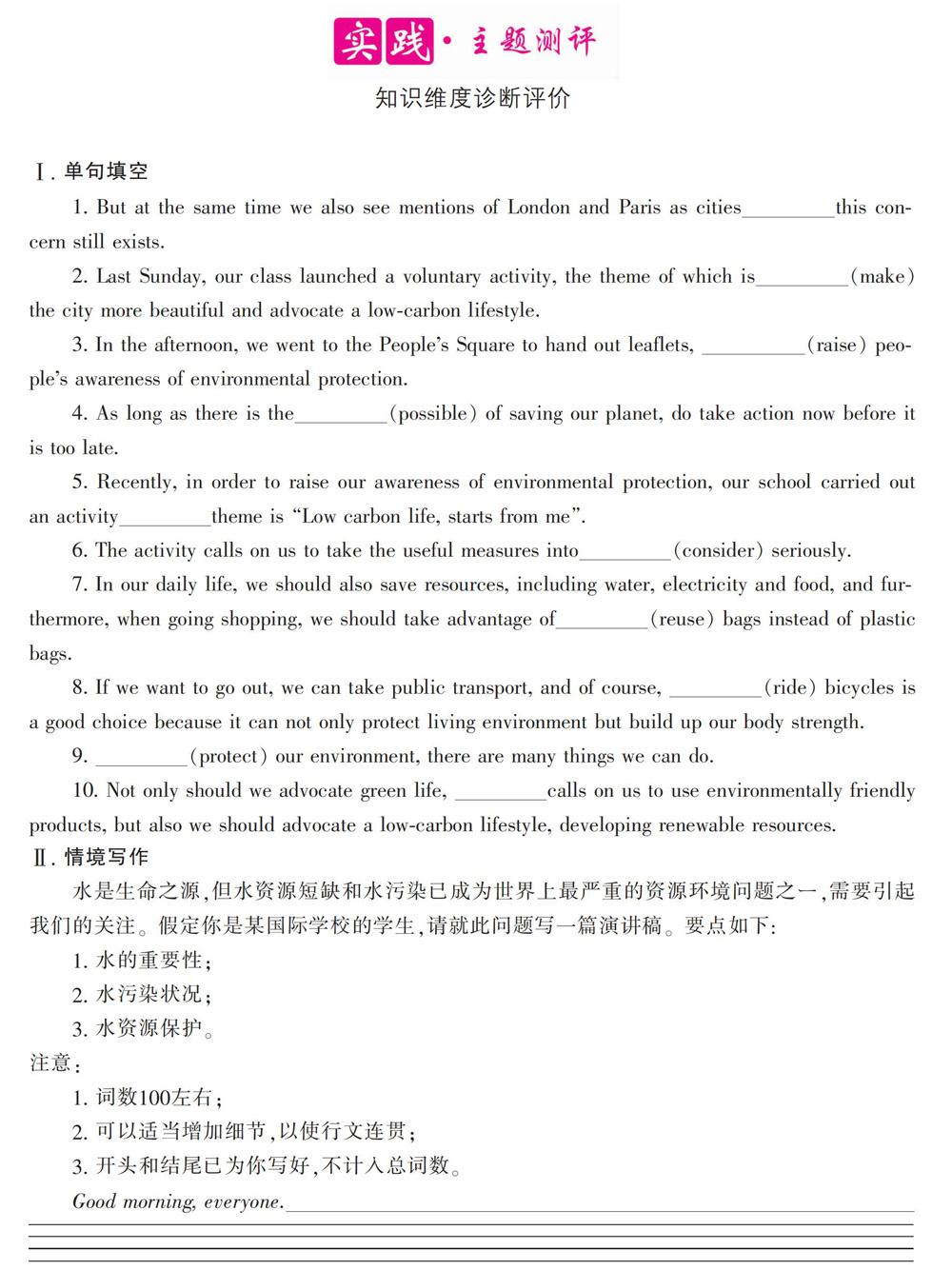主题语境十七:世界与环境
蒋建平



人类社会与自然环境相互依存,人与自然应和谐相处。但是近年来人们为了自身的发展,破坏了部分地区的环境状况,造成了环境的严重污染和退化,这将严重威胁人类的生存和发展。当前,随着国家对环境问题的重视程度不断提高,高考从引导考生核心价值观的角度出发,也会越来越重视对世界与环境类话题的考查。世界与环境主题包括动植物保护、生态保护、环境污染和保护等方面。它们与学生的生活息息相关。对这些话题的学习和高考英语对这些话题的考查,可以让学生多注意身边的人和事,关注社会环境,树立环保意识,学会与大自然和谐相处。
课标中“世界与环境”主题涉及的主要内容有:(1)Countries and maps(China, Great Britain, United States, Australia, Canada, New Zealand, Japan, Russia, India, Egypt, Cuba, etc.);(2)Issues(population, land use and quality, population growth, housing, etc.)。
关于“世界与环境”主题的写作常有以下几个命题角度:介绍国家或城市、介绍“地球日”活动、水资源的合理利用、公共卫生意识、日常生活中的环境保护、动物保护、垃圾分类等。
The worldwide plastic problem
Plastic is everywhere because its almost 1. (end) useful. And when its thrown away,
2. plastic finds its way into a plant, a lot of it can be made into something useful all over again.
But every year more and more plastic waste ends up in the ocean. And a global team of scientists has now tracked the production and disposal of plastic all around the world and used that information 3. (forecast) the scale of our plastic pollution problem for the next 20 years.
Household waste, the scientists say, is by far the 4. (big) source of all this pollution. They calculated that every year 30 million tonnes of waste is dumped on land; nearly 50 million tonnes of waste 5. (burn) out in the open, and thats in addition to the 10 million tonnes of waste that finds its way into our oceans.
Many of us might do our bit with reusable water bottles and coffee cups. But theres an
6. (estimate) two billion people in the southern hemisphere who have no access to any formal waste collection—theyre simply left to work out 7. to do with all their rubbish.
8. (provide) protection and safe employment for workers in low?income countries who collect and sort all of that waste will be just as important 9. (global) as reducing the production of single?use plastic. And while these new figures are daunting, the researchers say that recognising the source and the scale of this problem is 10. first step in stemming the worldwide tide of plastic pollution.
遍及全球的塑料污染问题
塑料无处不在,因为它的用途几乎是无穷无尽的。当塑料被丢弃后,如果被运到了像这样的废物处理厂,大量的塑料垃圾就可以被重新制成有用的东西。
但每年都有越来越多的塑料垃圾流入海洋。一支由多国科学家组成的团队现已追踪了世界各地塑料的生产和处理情况,并用这些信息预测了未来20年塑料污染问题的严重性。
科学家们表示,生活垃圾是塑料污染的最大来源。他们计算出,每年有3,000万吨塑料被倾倒在陆地上,近5,000万吨被露天焚烧,此外还有1,000万吨流入海洋。
我们中的许多人也许会尽一己之力,用可重复使用的水瓶和咖啡杯。但据估算,在南半球,有20亿人没有任何正规的垃圾收集渠道,他们只能自己想办法处理所有的垃圾。
在全球范围内,为低收入国家收集和分类垃圾的劳动者们提供保护和安全的就业环境,将与减少一次性塑料的生产同等重要。尽管这些新数据令人生畏,但研究人员表示,认识到塑料污染问题的根源和规模是遏制全球塑料污染浪潮的第一步。

